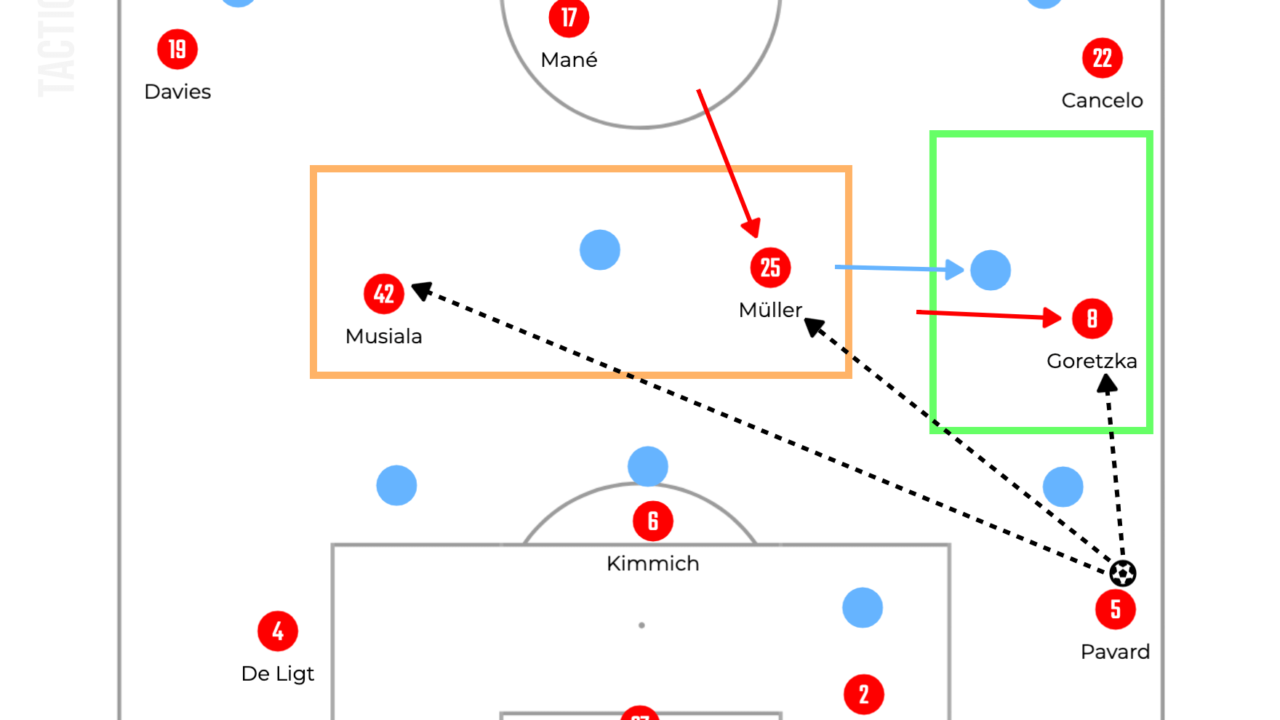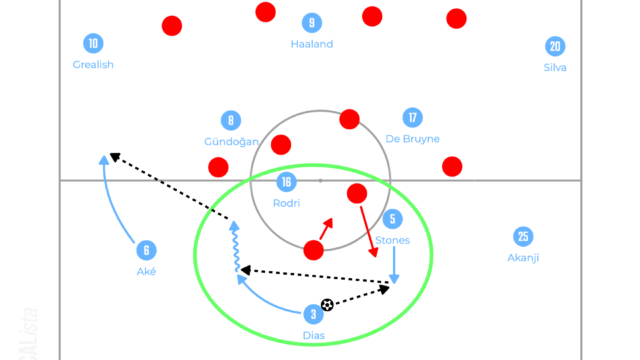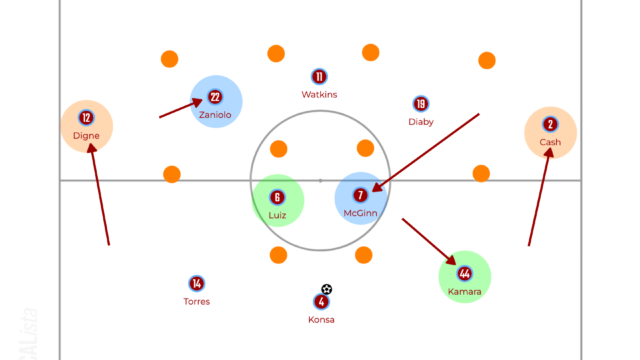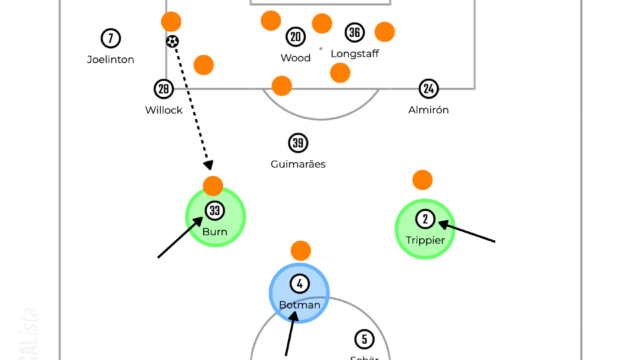FC Bayern München 22-23 Tactical Analysis [Julian Nagelsmann’s Unique Back 3 & Automatism in Attacking]

Introduction
Surprisingly, Julian Nagelsmann was sacked by the club and Thomas Tuchel was appointed to the new manager of FC Bayern München. Nagelsmann managed to secure the place of the quarter final of UEFA Champions League this season but after the defeat against Bayer 04 Leverkusen, Bayern dropped to the second place of Bundesliga. However, being a point below Dortmund was the true reason of replacing the manager? Or did they appoint Tuchel to just beat Manchester City in the Champions League as he did a few years ago? Nobody knows. Anyway, in this article, the recent tactics of Nagelsmann at Bayern will be analysed, and it may help us to understand problems on the pitch, which could have been one of the reasons of his departure. I hope you will enjoy it.
Build up
Like other modern managers, Nagelsmann also preferred to build up from the goalkeeper. The system of the team could be described as a 1-3-1-2-4 with both wingbacks staying high like wingers to pin the opposition back line.

As one of the characteristics of the back three, the key is the position of the central centre back, Dayot Upamecano. When the goalkeeper has the ball, centre backs will drop next to him. In the case of the back three, however, if the central centre back positions himself in the left side of the goalkeeper, the shape will be asymmetrical and the left side where the central centre back is will be overloaded. In Bayern’s case, as Yann Sommer hardly controls the ball with his left foot, Upamecano was often positioned in the right side of him and the ball was played to the right side. Additionally, his sense of moving to the right place to receive the ball is precise. After playing to the right centre back and as soon as realising Joshua Kimmich is far away to receive the ball, he often stepped up to make an option to play through. This movement was seen even when they had the ball in the midfield and he helped Kimmich a lot.

The objectives of build up against high pressing teams were finding the attacking midfielders or dropping strikers in between the lines. Thanks to the nice and high positions of the wingbacks, the opposition defenders were pinned and not able to step up to press. Thus, one of the patterns which was seen a lot was playing through to one of the attacking midfielders drifting wide areas. This area cannot be covered because the fullback is pinned and the wide player is pressing to the Bayern’s centre back. Additionally, if one of the midfielders followed the movement of the attacking midfielder moving towards the wide area, there would be a space in the middle of the pitch and one of the strikers, Thomas Müller in many cases, or the opposite attacking midfielder could exploit there. Then, the wingbacks or one of the strikers could run in behind and create artificial counterattacks.

In the midfield, the basic movements to break the opposition midfield line did not change. However, against the more compact pressing, playing around to the wingbacks and playing over from Upamecano were performed more frequently.

Of course, the attacking midfielder moved to wide areas to receive the ball or strikers dropped to receive the ball in the midfield as well as they did when playing the ball from the goalkeeper. Overall, the phase of progressing the ball was great thanks to some automatism of movements and individual qualities, and it is possible to say that Nagelsmann did really good job here.
Final Third Attacking
Against low defensive blocks in the opposition half, Nagelsmann’s Bayern showed some automatic movements. When the opposition teams closed the gap in the middle well, the pass to the wingback was the way to break the opposition midfield line and this was the trigger to perform movements. To make an option to play through the opposition back line, the ball side attacking midfielder ran into the channel. Then, this movement can create a gap to play a split pass in between lines. One of the strikers, mainly Müller again, created an option in between lines and they tried to exploit the space in the middle when it was not able to play in behind.

This kind of combination of the attacking midfielder and the striker was the key element for Bayern. They were excellent at sharing the space. If one of them made a run in behind, the space was made in between the lines and used by another. Or if one of them drifted wide to receive the ball outside of the opposition defensive block, the other made an option in the middle. This interaction between them was one of the characteristics of dynamic positional play.
Additionally, another way of exploiting the space between the lines was carries by the attacking midfielder. Especially, Jamal Musiala or Leroy Sané excel at receiving the ball between the opposition wide midfielder and defensive midfielder and carrying the ball with their skill of dribbling. Then, the best scenario was breaking the opposition back line, but if the back line was narrow, the through pass to the wingback was the option to penetrate the box.

Thanks to their individual quality, Bayern’s ability to break the opposition lines in the middle was one of the best in Europe. However, if the opposition players tried to defend the space in the middle so tightly, it was difficult to use the compact area in the middle even if it was Bayern. In that case, to increase the probability of scoring goals from crosses is important. One of the frequent patterns which Nagelsmann’s team preferred was crosses from a wingback to the another in the opposite side. The goal Kingsley Coman scored against his former club Paris Saint-Germain in the first leg of the round of 16 in the Champions League this season was exactly this pattern. From the defending perspective, it is difficult to keep marking the opposition attacker arriving in the box from the blind side. Additionally, the opposite wingback could be unmarked in many cases thanks to many attackers in the box. This was supported by one of the key tactics of Nagelsmann, which was the extreme high line. As the back three stepped up beyond the halfway line, Bayern’s midfielders could also move up front. The latest goal against Leverkusen scored by Kimmich was the great example. When the ball was crossed, there were five players in the box and the defensive midfielder Kimmich scored around the penalty spot.

This high line was one of the strengths but also weaknesses. By keeping the whole shape compact, it was possible to regain the ball after losing it. The transition after losing the ball was trained well as all players reacted quickly and always tried to apply pressure on the ball or the opposition players. Additionally, the centre backs stepped up to mark the opposition attackers to prevent them from receiving the ball.

However, this was one of the weaknesses of Bayern. As accepting 1v1 at the back when the transition occurred, there was a risk of being exploited the huge space in behind if one of them lost the individual duel because nobody was ready for covering it. Actually, against Borussia Mönchengladbach, Upamecano was sent off by being exploited the space behind him, but it should have been covered by the left centre back Daley Blind. Usually, these duels were won by Bayern’s defenders thanks to their superiority of individual quality, but this could be one of the weaknesses of them.
Out of Possession
The key of high pressing was both wingbacks. The shape was often a 1-3-2-3-2 or 3-1-4-2 as both wingbacks played as wide midfielders rather than fullbacks and Leon Goretzka sometimes positioned himself next to Kimmich. The objective of pressing as a team was extremely simple. Their movement of pressing was often an arced run to force the opposition player to play wide. Additionally, the wingbacks did not press vertically like natural wingbacks, but they also pressed the opposition fullback from the inside to the outside. This is one of the unique features of Nagelsmann’s wingbacks. Then, the ball side centre back played like a fullback and stepped up and covered the space behind the wingback. To support this aggressive structure, defensive midfielders Kimmich and Goretzka needed to work hard. Their job was not only marking the opposition midfielders but also covering the space behind the wingbacks or side centre backs if necessary.

However, no matter how hard defensive midfielders worked, this tactic of pressing was too dangerous. The defenders were basically focusing on the opposition attackers as they did in the defensive transition. Thus, gaps between each defender were sometimes so huge that the opposition team could exploit them. Additionally, due to the necessity of hard working, the space around the defensive midfielders was often stretched. Overall, the pressing was too aggressive and relied on individual qualities. This area could be the biggest weakness of Nagelsmann’s tactics.
Conclusion
In short, his tactics in possession functioned well thanks to some automatic patterns and individual qualities such as Musiala’s carries to penetrate the space between lines. Also, the extreme high line made it possible to react the defensive transition to win the ball back quicker. However, this was one of his fragile characteristics. Due to the man marking at the back, it was possible for the opposition team to exploit the space in behind and defenders could not cover each other. It was seen when they were pressing. This dependency on individual qualities was his weakness. Thanks for reading. I hope you enjoyed it.


